Article by James Broughel, Senior Research Fellow courtesy of the Mercatus Center
The term “red tape” describes outdated, unnecessary, or otherwise excessively burdensome regulations that do more harm than good. Whereas some regulations are justified, red tape imposes unnecessary costs on society, is often regressive, slows economic growth, and limits upward mobility for the most disadvantaged in society.
Without the necessary procedures in place to constrain red tape, it gets out of hand. Regulators have incentives to write regulations, but very often they have little or no incentive to review or remove old regulations that have outlived their usefulness. Furthermore, regulations create constituencies that benefit from the regulations’ continued existence, and these constituencies fight to preserve regulations once enacted, even when those regulations are causing problems. Because of these imbalances, more regulations generally get added to the lawbooks each year than are taken away, and as a result, the body of law in a jurisdiction grows larger and more complicated. This process, called regulatory accumulation, slows innovation and limits growth. Thus, it is critical that governments implement procedures to review and remove red tape that accumulates over time, lest the regulatory system and, by extension, the economy grow more sclerotic and dysfunctional.
One way to constrain red tape is through the issuance of a red tape reduction executive order, which is the focus of this policy brief. This report outlines six key steps of a successful red tape cutting reform, as identified in previous research from the Mercatus Center at George Mason University. Each of these steps is described in detail, and examples are presented in tables listing original sources where legislative or executive order language can be found that addresses the relevant step of the red tape cutting process. More detailed references to legal language are available in the source notes of the tables. This language should prove useful to governors, their staffs, and lawmakers who are interested in limiting red tape.
Adopt a Simple Measure
Any effort to cut red tape should start with a measure of regulation so that reformers can track their progress. However, tradeoffs inevitably arise between simple and more complicated metrics. A complicated measure, such as regulatory cost, could be hard to apply broadly to many policies, because very few policies have credible cost estimates. A more easily applied measure, however, may only roughly approximate the true regulatory burden. The optimal tradeoff might be to use simple measures applied broadly to as many laws as possible, but to supplement them with more complicated measures on a case-by-case basis (for example, for some of the largest individual regulations).
Some states, such as Idaho and Missouri, have opted to measure regulatory restrictions, which are counted in the Mercatus Center’s State RegData dataset. A restriction is an instance of terms such as “shall” or “must” in state law. States such as Ohio and Oklahoma have also used variants of the regulatory restriction metric in their reforms (see table 1). Meanwhile, other states, such as Virginia, have tasked regulatory agencies with producing a manual count of all regulatory requirements on their books. This approach requires more time and effort to produce, because it involves reading through an agency’s policies, but may result in a metric that is less easy to manipulate than a keyword search and a more meaningful proxy for regulatory burden.
Another benefit of a simple measure is that some jurisdictions, such as British Columbia, apply their measure to a broad range of policies beyond just regulation, including legislation and policy documents. Virginia, by contrast, focuses more narrowly on requirements in those administrative regulations that were within the discretion of the regulating agency to change and were not mandated by statute.
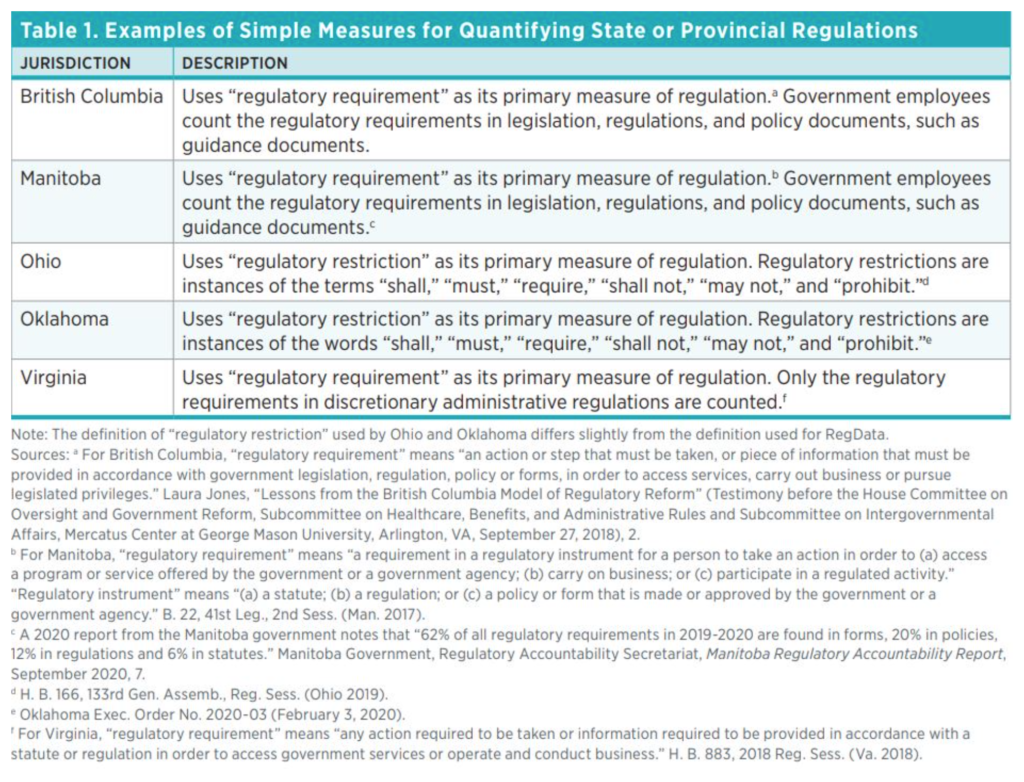
Create a Base Inventory
Just as a ship captain needs a compass, a red tape cutter needs a guide for his or her journey. If a president, governor, legislator, or regulator’s goal is to reduce regulation levels, then he or she needs to know the direction he or she is heading. An initial count of all the regulations on the books, using the measure identified in the previous section, is a critical first step. This initial count is sometimes referred to as a “base inventory,” and it tells reformers where they are and helps them get to where they want to go.
To produce a base inventory, an initial review must be conducted. As part of this review, it can be helpful to classify regulatory requirements or restrictions by whether they are mandated by state or federal law or exist at the discretion of the regulating agency. Ohio and Virginia have chosen to classify their regulations in this way when establishing their base inventories. Arizona’s five-year review process also requires classification of rules by whether they are mandatory or discretionary (see table 2).
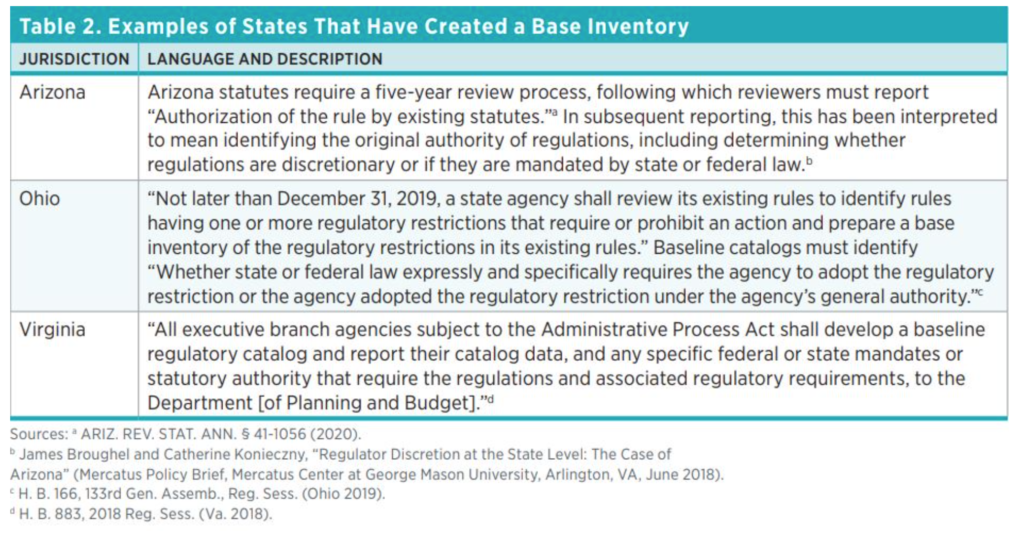
Set a Reduction Target
To return to the ship analogy, a regulatory reform without a goal is like a captain sailing aimlessly without a destination in mind. Regulatory agencies involved in efforts to cut red tape need a goal so that they have something to aspire toward and so that they know when they have succeeded. Whereas it is ultimately a political decision as to what the appropriate goal should be, several factors can inform the decision as to how much red tape is the appropriate amount to cut.
Ohio has more than 100,000 more regulatory restrictions than the average state, according to State RegData. In response to this information, Ohio legislators proposed a 30 percent reduction (see table 3), which would have put its number of regulatory restrictions closer to that of the average state and also nearer to its close competitor Pennsylvania.
This 30 percent reduction goal is similar to goals in other jurisdictions, most notably British Columbia (33 percent), Kentucky (30 percent), Missouri (33 percent), and Oklahoma (25 percent). Thus, it seems that many governments believe that cutting regulation by somewhere near one-third is a realistic goal. Rhode Island cut its regulations by 31 percent in terms of rule pages, and Idaho and Missouri cut their regulatory restrictions by 37 percent and 30 percent, respectively, so these goals may not be out of reach.
Another factor to consider is whether the reduction target should apply broadly across the whole government or whether each agency should have to meet a unique target. States such as Idaho and Missouri have achieved substantial reductions in their regulatory codes, but the reductions vary greatly by agency. If a single, across-the-board reduction is too blunt a tool, a reduction target could be an average goal that is exceeded at some agencies but not at others. Or there could be have a process for agencies to explain why they should be exempt from meeting the target. In either case, some kind of oversight body may need to possess the authority to determine which agencies need to cut and by how much and when exemptions should be allowed. This idea will be discussed in the next section.
Some states, such as Virginia, have targets that apply only to discretionary regulations—that is, regulations that can be amended or repealed without further legislative changes. If agencies fail to meet their reduction goals, Virginia law provides that a one-in, two-out provision will be considered as a backup (see table 3).
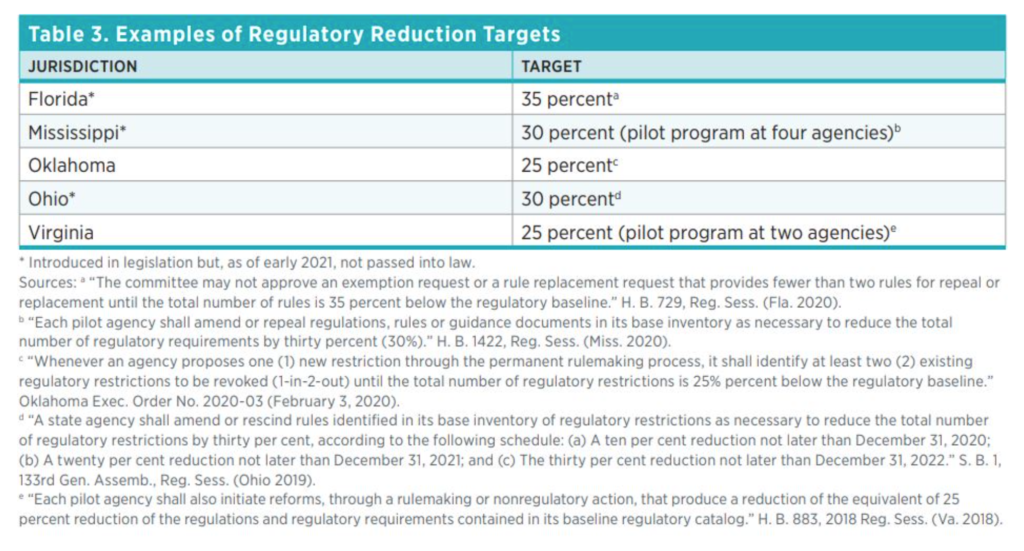
Create an Oversight Authority
Regulatory agencies may try to game the red tape cutting process in several ways. First, they may claim that certain regulations are being repealed as a result of a red tape review, when in fact the same rules would have been repealed even in absence of any such review. Second, agencies may try to combine rules or requirements, for example, by eliminating instances of “shall” and “must” in regulatory language, without changing the substance of requirements. Third, they may try to incorporate by reference certain regulations. This means that text is removed from state laws, but a citation is left in the text to other laws, so that the result is less text but no change in legal requirements.
Each of these actions is not in the spirit of a sincere red tape reduction effort. As such, an oversight authority is needed to ensure that regulatory cuts are substantive. This authority could be a commission created by the governor or the legislature, as existed in Illinois and New Jersey in the past (see table 4). Or it could be a state agency like the state budget department in Idaho or Virginia.
Personnel matter too. In New Jersey and Illinois, red tape commissions have been populated mostly with political personnel, some of whom have been legislators or legislators’ designees. In Idaho, the director of the Division of Financial Management has overseen reforms, and in Virginia this job has been performed by the Department of Planning and Budget, which is overseen by the secretary of finance. Idaho has also established rules review officers within each department, people whose specific mission is to “undertake a critical and comprehensive review of the agency’s administrative rules to identify costly, ineffective, or outdated regulations.”
Whoever is put in charge should produce annual reports on the progress of reforms. Reporting should track the amount of regulation by department or agency, include stories of problematic regulations that have been repealed (which is useful for communicating the results of reforms to the public), and recommend laws to be modified in order to enact further reforms. Reporting helps build a narrative about what is being accomplished by reforms and documents successes and challenges for the historical record.
New Jersey may exemplify a best practice in regulatory oversight and reporting. In 2010, the governor established a bipartisan commission to oversee the effort to reduce red tape, and he took steps to ensure a bipartisan makeup of the commission. The quality of reporting from the commission was quite high, and many of the recommendations in commission reports were later taken up by the legislature and adopted into law. This reform has been judged to be so successful it inspired legislation introduced in late 2020 that would create a permanent, bipartisan Government Efficiency and Regulatory Review Commission that would review all proposed and adopted rules as well as the governors’ executive orders and issue annual reports to the governor and the legislature.
Manitoba is another jurisdiction that exemplifies a best practice in oversight and reporting. Manitoba’s Regulatory Accountability Committee of Cabinet ensures compliance with the province’s red tape reduction law. Annual reports from the Regulatory Accountability Secretariat show counts of regulatory requirements, broken down by whether requirements come from forms, policies, regulations, or statutes. Counts are also broken down by agency.
Reporting provides transparency on the size and scope of the regulatory state. Therefore, reporting should be ongoing and should continue even after a reduction target is met. In fact, reporting could be a useful reform in its own right, even if not tied to explicit reduction goals. If it is not politically feasible to implement a red tape cutting reform today, instituting a reporting requirement will make red tape reduction easier in the future when reform is more politically feasible.
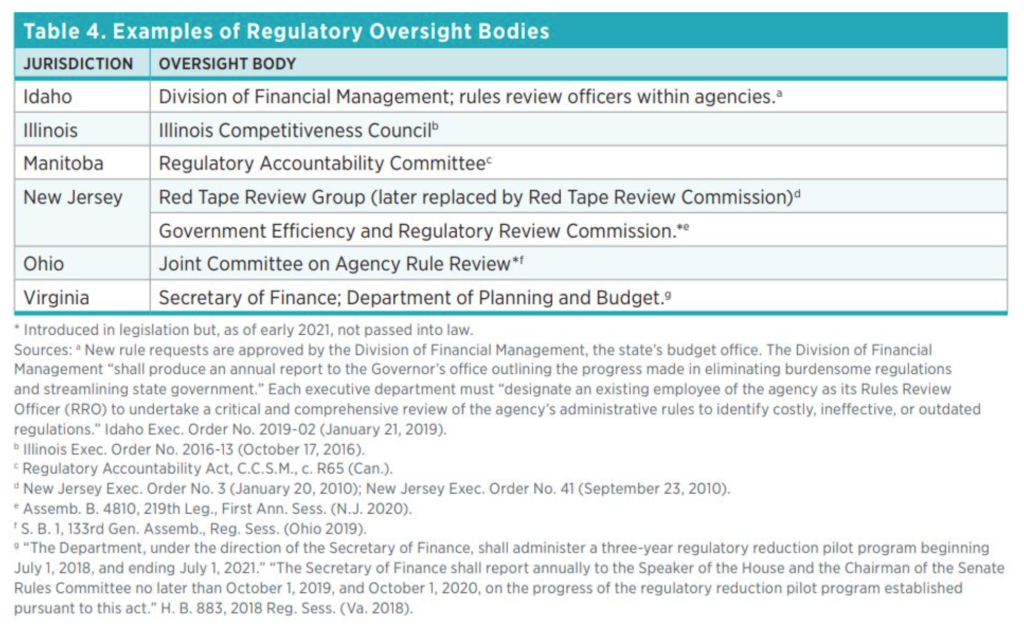
Establish a Process
One aspect of human nature is resistance to change. As such, regulators are likely to initially resist any change to their routine. However, small changes to the rulemaking process can help motivate regulators and change the culture at agencies so that regular review of old rules becomes a part of regulators’ everyday jobs.
One such process change is a one-in, two-out requirement, whereby for every new rule added to the books, two are removed. Such a policy has several benefits. First, it communicates to regulators that they should be prioritizing reducing burdens over adding new burdens. Therefore, it instructs them to change their focus. Second, it encourages retrospective review of old regulations. Third, over time the policy can change the culture at regulatory agencies such that regular review of existing rules becomes a part of the regulatory culture. Finally, a one-in, two-out requirement is easy for the public to understand, making it a useful rhetorical device to communicate that reducing red tape is a priority of the government. A one-in, two-out policy has been implemented in places such as Idaho, Ohio, and Oklahoma (see table 5).
Other process changes worth considering include building sunset provisions into regulations or mandating the repeal of rule chapters in the code on a set time schedule. The former approach was taken by Governor Rick DeSantis of Florida. In late 2019 he issued a letter to agency heads directing them to build sunset provisions into regulations going forward. The US Department of Health and Human Services also finalized a regulation in early 2021 that builds sunset provisions into the agency’s titles in the Code of Federal Regulations. A key difference between these two strategies is that the Florida order mandates that sunset provisions be built into new rules going forward, whereas the federal regulation inserts a sunset provision into the department’s rule titles such that the provision was attached to existing regulations as well.
Idaho has taken a third approach, which is requiring periodic repeal of regulations (referred to as “zero-based regulation”). Through an executive order in 2020, Governor Brad Little required that approximately 20 percent of rule chapters be reviewed each year and that agencies be required to repeal regulatory chapters under their purview as part of these reviews. If the agencies want to replace the rules, they will have to refile chapters as new regulations and justify them with accompanying economic analysis.
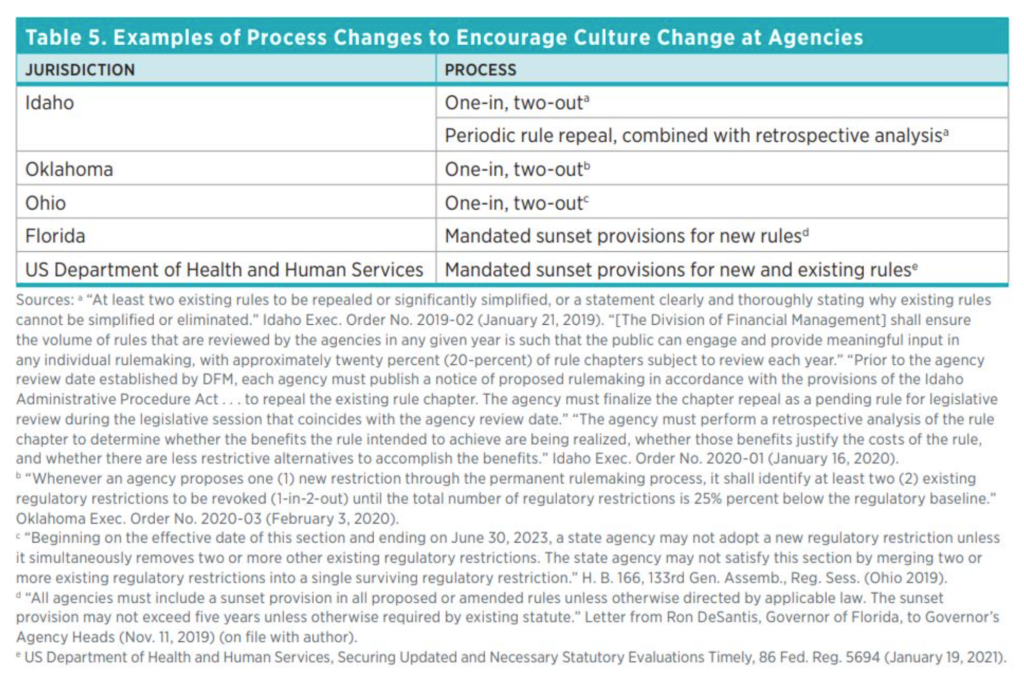
Cap the Code
Once a reduction target is met, it is critical that regulatory agencies do not return to business as usual. The natural tendency in government is for the volume of regulation to grow. A final cap is needed to lock in successes that are achieved and to maintain the reduction going forward. A cap also helps promote a permanent change in the culture of government, not just a temporary one.
Regulatory caps can come in several forms (see table 6). First, a one-in, two-out policy that may have accompanied a reduction goal can be converted into a one-in, one-out cap after the reduction target is met. This was the approach taken in British Columbia, for example. A cap could be placed on the costs agencies impose. The Trump administration used this approach, and it seems to have been fairly successful at preventing regulatory creep. Texas also has a one-in, one-out requirement, where the relevant offset is measured in terms of cost. Idaho, after a year of one-in, two-out, imposed a cap on regulatory burden. In practice this may mean that a cap is placed on the total number of words an agency can have in its rules.
Conclusion
This policy brief has identified a series of best practices associated with creating a successful red tape cutting reform, and it provides examples of legal language that have been used in previous regulatory reforms, language which may prove useful to governors, regulators, and legislators. Notably, most of the actions described here can be implemented through executive actions, although legislative solutions will surely prove more binding and more enduring.
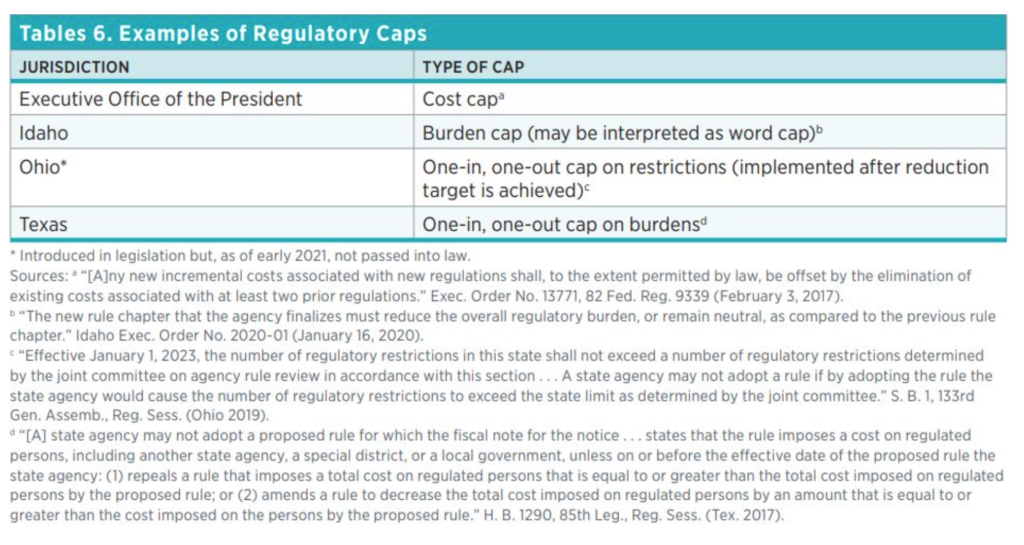
Each of the steps presented here are important, though jurisdictions should have flexibility to implement each aspect of reform in a way that meets their unique needs and circumstances. Owing to resource constraints, some states might adopt a very simple measure, such as regulatory restrictions, whereas others might choose a more complex one, such as regulatory requirements or costs. Some states might apply reforms broadly to all regulations and policy documents currently in existence; others might focus narrowly on discretionary regulations to start or perhaps home in on a small number of problem agencies as part of a pilot program. Some states might opt for an aggressive reduction target on the order of 30 percent or more; other states might set more modest goals.
Whatever approach a state ultimately chooses, reforms should be transparent, be subject to oversight, and have specific goals from the outset such that the public can monitor progress. Every state should have procedures for constraining red tape. This policy brief has offered a road map for how to do it.
